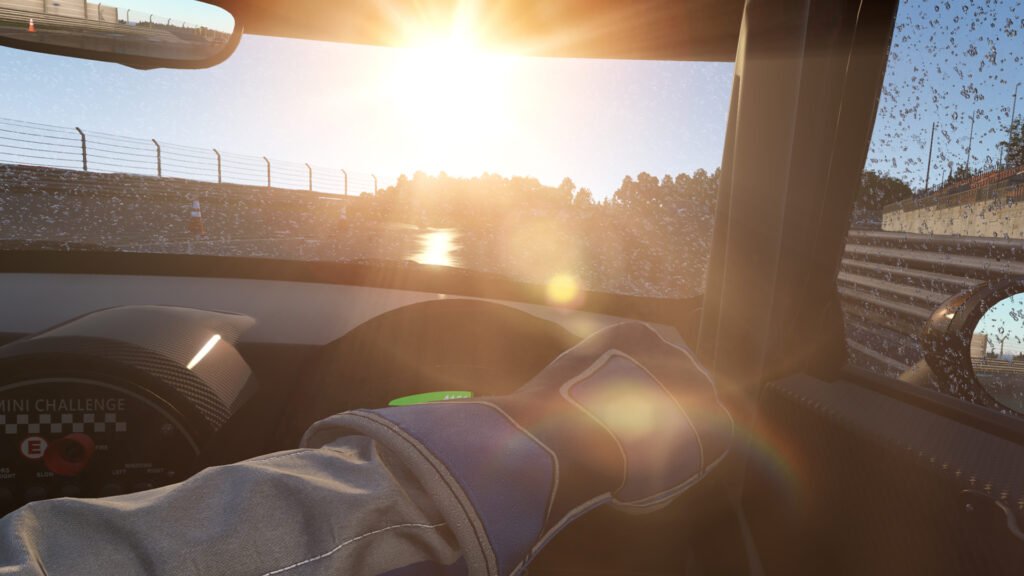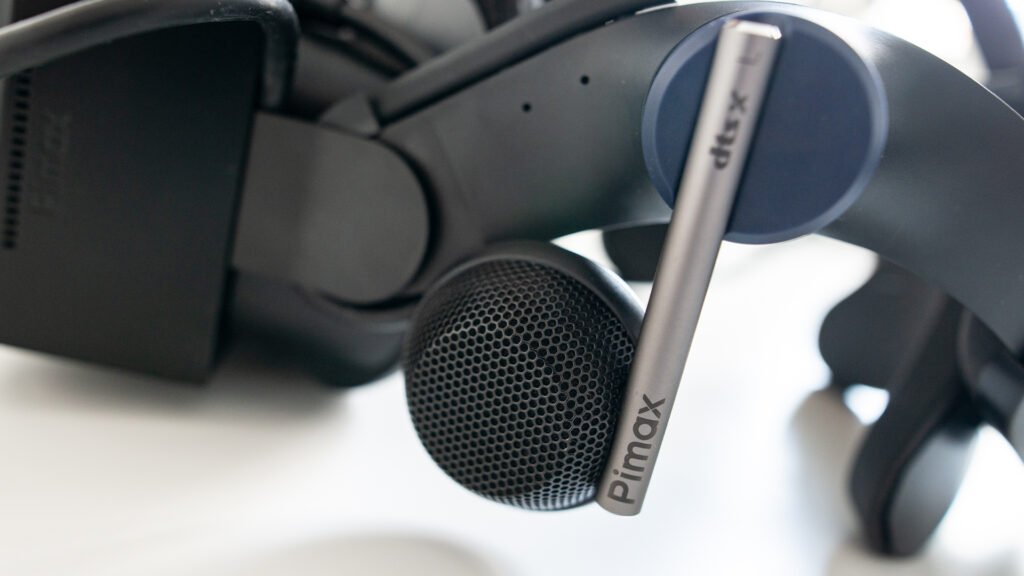‘Looks like I picked the wrong week to quit drinking’.
So said Steve McCroskey, an air traffic controller facing the onerous task of talking down an airliner piloted by the hapless Ted Striker.
Thankfully, this is just the plot of Airplane!, a 1980 movie starring Lloyd Bridges and Leslie Nielsen. It’s widely considered to be one of the best comedies of all time.
But my week testing the Pimax Crystal Light was anything but funny, with what’s left of my receding hairline taking several, rage-induced hits.
It wasn’t all bad, though, with the Crystal Light proving to have some serious gaming horsepower once set up.
It was getting to that point that proved difficult for me, however…

Surely you can’t be serious?
The Pimax Crystal Light is nearly identical to the Pimax Crystal. Both headsets share the same specifications and produce similar results but the key difference is the Crystal Light is a dedicated PC VR headset.
This means it must be connected to a PC to function: it has no battery pack so it derives its power from an AC adapter, with connections to your PC via DisplayPort and USB3 cables. So, out of the box, it doesn’t have any wireless functions or eye-tracking abilities.

However, for sim racers, this is arguably good news. Cutting out the battery saves weight, meaning virtual drivers should be able to tackle an endurance race without looking as sweaty as Ted Striker during Airplane’s denouement. At least, that’s the idea.
In the three years I’ve been using my Meta Quest 2 I’ve always raced while connected to my PC. Cables give your VR sessions a more secure connection, which is vitally important for those who sim race, so, for me at least, I don’t see the Crystal Light’s wired-only approach as a negative.
I am serious. And don’t call me Shirley.
The Crystal Light has some serious specs, boasting 2880 x 2880 resolution per eye. Compare that to the 2064 x 2208 of its (arguably) biggest rival, the Meta Quest 3, and you can see where its advantage lies.
Its aspherical lenses boast a larger ‘sweet spot’ in vision, but the lack of eye-tracking means players have to adjust their interpupillary distance (IPD) setting manually. It’s no hardship and Pimax’s ‘Play’ software even allows you to fine-tune adjustments for each eye. No ocular drift here, no sir.

The Crystal Light’s field of view is fairly spacious at 125 degrees too, and its refresh rate can be switched between 72Hz, 90Hz, and 120Hz (60Hz will be supported in future), with a very compact 35 PPD (pixels per degree) rating helping supply class-leading clarity.
And boy, does it deliver out on track.
Ah yes, I had the lasagna
I’ll get the negatives out of the way first. I found setting up the Pimax Crystal Light to be a chore. Despite connecting everything up correctly, the headset refused to display anything, although I had sound.
After a convoluted troubleshooting process, where I set the Pimax software to ‘run as administrator’ and ensured my antivirus excluded the Pimax folder, I found that reinstalling the Pimax Play app did the trick.
After all that, I required a ‘rejuvenating’ whisky.

I came back to my PC later for another VR session and found I had the same issues. I reinstalled the Pimax Play app and got going again. Then I experienced some random boundary lines while playing Assetto Corsa.
Addressing this mid-session caused AC to stop working, as readjusting the ‘active chaperone’ (also known as the ‘Guardian’ in Meta-speak) mid-game shuts it down. Pimax Play also randomly defaulted to the ‘Stand’ position instead of ‘Sit’, so I’d be staring at the pedal box of my car instead of out the windscreen. The faff of shutting the game down and messing around with settings became quite laborious.
I counted to 10 and had another whisky.
After contacting Pimax support, they assured me the issue would be fixed in a subsequent update, but I later discovered that if I started the Pimax Play software and then restarted my PC, everything would work perfectly well. Phew, a workaround!
The unboxing process was fairly underwhelming, although all items were packed securely. The headset itself is made of fairly cheap-feeling (and looking) plastic; it all feels a little flimsy but is much stronger than it looks.

The headset design is a little bulky and unattractive too, but is quite comfortable and easy to wear with glasses (using the default face pad). The rear section of the headset sticks out quite a bit, however, which forces my neck into an awkward position against the headrest of my gaming chair, which can be a little uncomfortable.
I never found a solution to this, so my guess is an aftermarket head strap may help. Despite this, the Crystal Light’s overhead strap system feels very secure and the headset doesn’t feel as unwieldy as it looks. Even when it heats up my face remains blessedly sweat-free.

The package Pimax supplied us came with the optional DMAS Earphones, which are a significant upgrade on the default option. They’re simple enough to fit but the screw holding the old cans in place is unbelievably tight and well beyond the capabilities of the supplied screwdriver.
I had to have another whisky after this screw-burring trauma, purely for medicinal purposes you must understand.
All of the Pimax Crystal Light’s flaws made me feel a bit like George Zip on his futile mission over Macho Grande, but the Crystal Light does have some pretty significant strengths.

Pimax Crystal Light: a visual delight
Amid much consternation, the VR experience from the Crystal Light is incredible. Firing up Automobilista 2 (possibly the best sim to play in VR), I was amazed at the pin-sharp details. I could clearly read all the data displayed on the Formula Ultimate Gen 2’s steering wheel: no mean feat when tackling Eau Rouge at 180mph.
The clarity offered by its glass lenses is sensational, so I rattled through the sims currently residing on my hard drive: rFactor 2, Assetto Corsa, iRacing, Richard Burns Rally and Assetto Corsa Competizione. ACC in particular benefits from the jump-up in VR technology, but it’s a noticeably less engaging experience than AC or rFactor 2. iRacing is surprisingly resource-intensive (possibly more from the CPU side than the GPU), so needs a bit of fettling before it produces smooth results. Even then I wasn’t overly happy with the results.
Using Pimax Play, you can easily adjust the headset’s refresh rate and rendering quality – it’s a doddle. You can even turn off the active chaperone as well, thankfully.

The Crystal Light shares similar controllers to the Meta Quest 2, which look and feel uncannily similar. The Pimax controllers can be charged via USB-C, which is superior to Meta’s AA-battery-munching units, and lighter.
Although they don’t get much of a workout playing racing sims, the controllers worked really well in other VR-compatible games like the superlative Half-Life: Alyx. I had no issues with the button feel or placement, but the cheap-feeling plastic undeniably felt less premium than those on the much cheaper Quest 2 (and the Quest 3’s are better still).
The quality of the visuals from the Crystal Light’s QLED screens is quite remarkable and on one occasion I was so immersed in the action it had me reaching out to activate a car’s windscreen wipers. That’s quite the endorsement. An AMS 2 Mini JCW race on the Nordschleife was a particular highlight, with the race beginning in heavy rain, transitioning into a storm and ending in brilliant sunshine.
The way spray plumed up behind AI cars in the initial stages was unbelievably atmospheric, with the low sun forcing me to instinctively ‘do an Ari’ in lieu of a virtual sun visor. Magic.
However, the Crystal Light requires a hefty GPU to make it worthwhile, with my 4070 feeling the strain on occasion, especially in Half-Life: Alyx. The stability of its head tracking also deteriorated in such circumstances, with in-game movements not matching my inputs, making you feel like you’ve eaten a bad fish dinner on a plane…
Pimax Crystal Light vs Meta Quest 3 for sim racing
In terms of ‘new’ VR headsets, the Crystal Light’s biggest sim racing opposition is the much cheaper Quest 3 (the more specialised Bigscreen Beyond could also be considered thanks to its high-res displays). Even though the Quest 3 has a bulky battery built-in, its headset surprisingly weighs 20g less than the Crystal Light’s.
For UK customers, the Pimax Crystal Light costs £916.80 with controllers, shipping and VAT included. The review sample Pimax sent us also included the uprated optional DMAS Earphones, which are another £100 inc VAT, so this is a £1,000+ unit, which isn’t cheap by any means. It’s also more than double the price of the Quest 3 at £479.99 RRP and does without Meta’s more substantial storefront (prices have been taken from Pimax’s official website).

The Pimax Crystal Light seems like the ideal sim racing VR solution on paper. Its undoubted talent for producing highly detailed visuals will win over many of the genre’s fans – to get better image quality you’d need to spend over £3,000 on an Apple Vision Pro – but its troublesome software is quite off-putting at this stage.
I found the VR experiences in AMS 2 and rFactor 2 to be almost flawless but had some difficulties attaining smooth performance in iRacing. Playing Assetto Corsa in VR was also a rather buggy experience.
If the Pimax development team can address the above-noted software issues they’ll be onto a winner, as the Crystal Light’s ability to provide an immersive sim racing experience is unrivalled at this price point.
Pimax aimed for the skies and stuck the landing. But only just.
We’ll be sure to update this review when more software updates arrive in future.
Update 26/8/24: I’m happy to report that I no longer have any issues with the Pimax Crystal Light’s software. It has very much become a ‘plug and play’ VR headset for me, thereby eliminating what I considered to be the Crystal Light’s biggest weakness.
Full disclosure: This product was provided by the manufacturer for review purposes. Here is our review policy.





Chat with the Community
Sign Up To CommentIt's completely Free